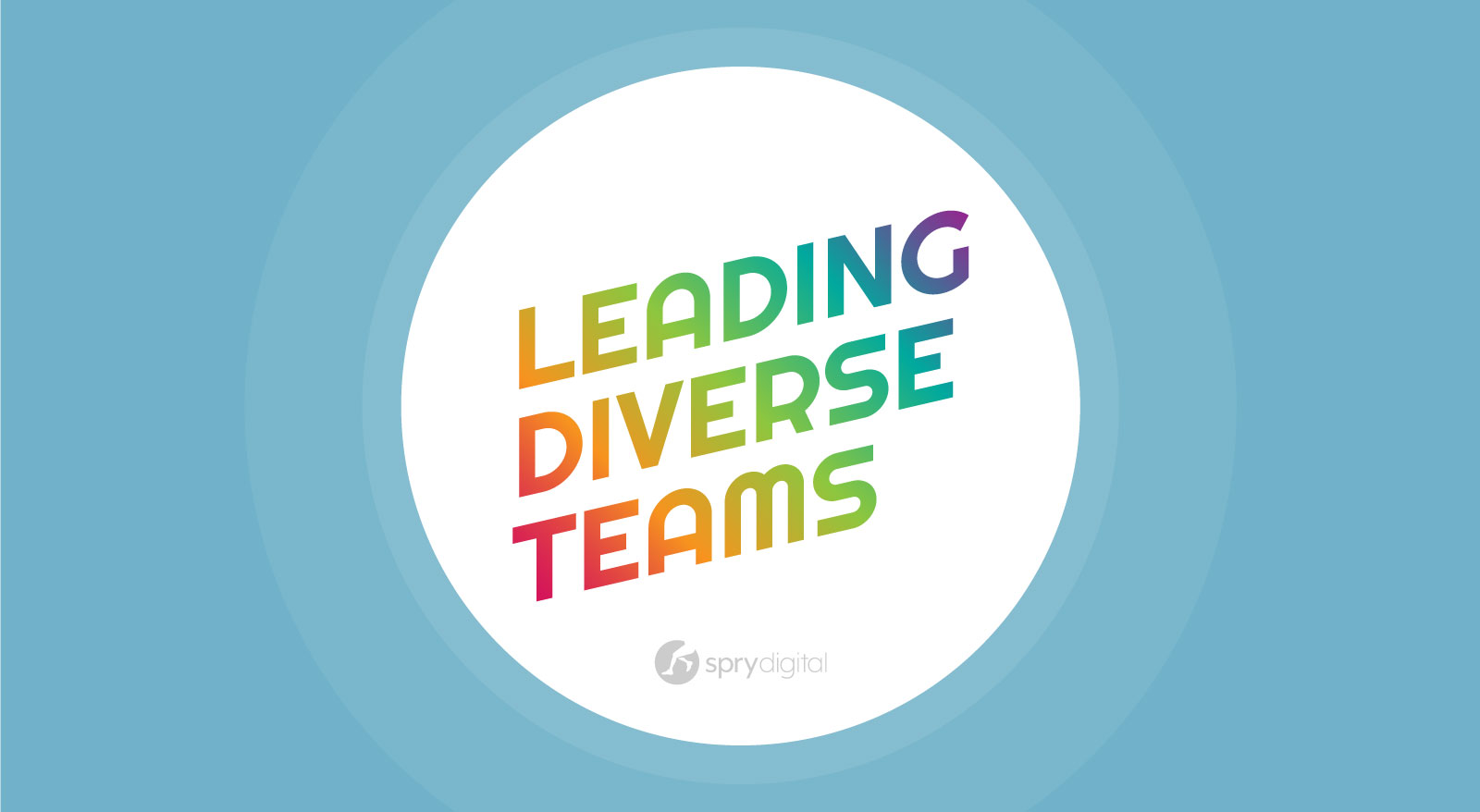Leading Diverse Teams

Why does diversity matter?
Creating a workplace where everyone is valued, regardless of their background, experiences, preferences, goals and aspirations, has been important to me for decades. It started with me being a woman in technology, a professional woman working in the financial services industry, a mother with high aspirations and an empath who cares deeply about each individual’s story. This mindset goes hand in hand with developing high-performing teams and achieving results.
Over the past 36 years, I developed a toolbox of strategies that have helped me continue to lead diverse teams. In this blog, I will focus on three strategies and practices – core values, adaptive communications and pervasive trust – that are key to creating an inclusive culture in which everyone feels they belong and works together to deliver results.
Diversity is the coexistence of people with different characteristics (race, age, gender, sexual orientation, experiences, culture, belief systems), skills, abilities and personality traits. Our workplaces must represent the world in which we live, the clients we serve and, in turn, the customers they serve.
Each individual brings with them perspectives, experiences and new ideas to improve what we do in our business. By checking our egos at the door, we have the opportunity to grow, learn from and understand each other. We are better problem solvers and develop better solutions when our team members are diverse, including having a balance of doers, followers, leaders, critical thinkers and high achievers. Diversity matters because it helps us make better decisions as a company and as individuals.
Inclusive culture and core values
A challenge with leading diverse teams occurs when team members do not agree. The solution is to find common ground in the shared core values we have in the organization and in the alignment of the results we want to achieve.
At Spry Digital, we use a framework called the Entrepreneurial Operating System® (EOS). This framework helps ensure our entire team is on the same page. The first step in the process is to clearly define your core values. These should be the core beliefs that everyone in the company lives by most of the time, those that define the “WHO” of your company. As the CEO, I must live by these core values and be committed to them. Likewise, each leader and team member must live and agree to them, as well. These values should be intentional and reflective of those shared beliefs that drive individual behaviors when we are under stress or dealing with a crisis.
Our leadership team identified characteristics of individuals in our company who delivered the results we expect from our team. We agreed on the following five core values (an update from our previous four) for Spry Digital:
- Drives for the best outcome
- Embraces challenges and learning opportunities
- Nurtures and lifts others
- Shows initiative and perseverance
- Communicates openly and honestly
Each core value has examples of associated behaviors. We expect people to exhibit these most of the time. This does not mean that everyone has to live all of the values all of the time. We are human; that isn’t possible. But we understand that the more responsibility someone has in the organization, the greater the impact of not living the core values has on the culture.
Once you have identified your core values, you must align your team with them. In EOS, we use a tool called the People Analyzer. There are many tools available, but the principle of ensuring you have the “Right People” is founded in the teachings of Jim Collins, author of “Good to Great: Why Some Companies Make the Leap and Others Don’t.”
Quarterly, leaders should have employees evaluate themselves against the core values and then have follow-up conversations with their team members to share their perspectives. When someone isn’t exhibiting the behaviors we expect, we should ask ourselves, “Have we given this team member the training, resources, mentoring, opportunities, time and attention needed to be successful? Do they have the equitable life experience to develop the knowledge, skills and abilities we need for them to become high performers?” Diversity requires that you meet people where they are and personalize your efforts to encourage your employees to embrace the behaviors that reflect your core values.
If you want a diverse workforce built on your core values, then your hiring process must include an evaluation of the candidates’ alignment with your core values. Warning: You will not always get this right. Secondary warning: Some team members will feel your culture doesn’t represent your core values.
Once you improve your interviewing process to focus on core values, culture and behaviors you expect, you have to extend that focus by reviewing, evaluating and rewarding based on those values.
A talent pipeline can also help you find diverse individuals who concur with your core values. This pipeline should include these key aspects:
- Intentional recruiting
- Career paths for new and existing employees
- Training curriculum for each career path
- Creating internships and leveraging career training programs
- Development of internal support systems for employees, such as sponsorships and mentorships
I have to admit, we don’t have formal systems for each aspect in our company. While we continue to evolve in the development of a talent pipeline, we do have an internship program that has allowed us to find the right people for our organization. It enables us to intentionally recruit for specific positions to ensure we find a diverse pool of candidates. That being said, this effort requires time and commitment.
Adaptive communications
In 1995, I read a book that profoundly affected me – “Working with Emotional Intelligence” by American psychologist Daniel Goleman. The five key elements of emotional intelligence are:
- Self-awareness
- Self-regulation
- Motivation
- Empathy
- Social Skills
These are key skills you need to build and lead a diverse group of individuals who have agreed to live a set of core values. You must be prepared to lead with humility, acknowledge when you fail and be willing to put the needs of others above your own. In research published by the Journal of Management Development, Loi, Golledge and Schutte discovered that individuals with high emotional intelligence are associated with higher positive impact and lower uncivil behavior.(1)
Self-awareness, one of the five facets of emotional intelligence, is essential to developing adaptive communication skills that allow you to work with diverse teams effectively. You first need to understand your communication and behavior style before you can adjust your communication with others. As you discover your communication style and how you make decisions, you can start to understand how those traits impact others.
Within any organization, you will find individuals who communicate differently and need information presented in distinct ways to make decisions. To help our team develop this self-awareness, we use an online tool called Crystal. Crystal provides insights on our people by asking a series of questions and then providing a DISC, Myers-Briggs and Enneagram profile for each.
Over the past three years, our leadership team has explored our differences in many ways. We have a very diverse mix of individuals who do not think or view the world the same. While each person has strengths that make them very good at what they do daily, our differences require us to become aware of how we must communicate with each other to enable faster decision-making and ensure everyone is on the same page. Adapting how we communicate with each other and being accountable for our messages being heard are critical. We also recognize that we need to teach our team members to understand communication and information-processing differences and how to adapt their communications accordingly.
The last – but certainly not least – aspect of adaptive communication is being an active listener. Leaders who are present focused on the speaker and asking questions for better understanding are more effective at leading diverse groups of people. They watch non-verbal communications and listen without forming a response or judgement. Creating a culture where everyone is heard and their experiences appreciated builds an environment in which people are willing to participate, share and contribute. When people do not feel that their opinions are valued or continually told they are wrong, they will not share their thoughts and contribute. Communication with teams is critical, and as a leader, you must be adaptive to team members and their needs.
Pervasive trust
When creating a culture that embraces diversity, celebrates differences and delivers results, trust is paramount to your organization’s success. I always think about sports teams when I think about trust. Some of the best teams – those that consistently exceed expectations – are composed of members who implicitly trust each other and their leaders.
To create trust, leaders must be role models, “walk the talk” and realize that their team is a reflection of themselves. Your people must come first and be treated with respect; they need to know you have their backs and support them.
As a leader, you must communicate, communicate and then communicate again (seven to 10 times). And when you have made a mistake or dropped the ball, you must acknowledge and own your failings.
Trust does not happen in a day but can be lost in a second. Developing our emotional intelligence through self-regulation helps us to seek to understand rather than react emotionally to someone. I must admit, this aspect does not come easily to me. I have had to work for years to develop self-regulation skills. I believe that raising three boys helped me build that skill. I also know that if I am not feeling well, didn’t get enough sleep or have several negative things happening at once, I am not good at self-regulating. I acknowledge this and have been known to cancel my day to ensure I am at my best when dealing with my team or clients. I also welcome the times when team members speak up, reach out and tell me that I wasn’t at my best. Being vulnerable is hard, but it gives me the space to be human and acknowledges that my team members are human, too.
As leaders with diverse teams, we must be curious about our people – what motivates them and what drives their behaviors. Understanding team members’ strengths allows us to put people in positions to succeed and acknowledge when we push for growth in an individual. It is our responsibility as leaders to give team members opportunities to learn new things and to create a safe environment for them to make mistakes. When our team members trust that we have their backs and will provide the safety net for failures that occur, they will embrace pushing themselves outside their comfort zones. On the other hand, if a team member cannot trust we will be there when they fail, they will never give their all to the organization.
How will you know that you have created a trusted environment for your employees? Your team members will feel like they belong in the organization, no matter their role. They will feel valued and give you their best every time. They will respect each other’s strengths and lift a team member up with support in their areas of weakness. Leaders will focus on an individual’s abilities and coach with a guiding hand. And you will see the results expected from everyone, because they are bringing 100% of themselves every day.
Creating a diverse team of individuals is not about filling quotas or meeting a minimum bar. It requires each team member to be intentional in wanting to learn from others who do not look like them, sound like them, or live their lives like them. It is focusing on core values that see every human being as an equal member of society and learning how to value their contributions based on their abilities. It requires us to put our egos aside and listen to learn. It means we must be willing to adapt our communications to ensure others hear our message instead of blaming them for not understanding. As leaders, we create teams that trust each other, support each other, work together for the greater good of the organization, and, in return, your clients.
Lead with intention. Love the opportunity. Be the change.


